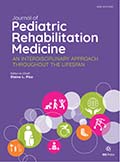Authors: Gill, Irwin | Davidson, Sue-Anne | Stevenson, Paul G. | Robinson, Rae | Pool, Dayna | Valentine, Jane
Article Type:
Research Article
Abstract:
PURPOSE: Intensive rehabilitation aims to improve and maintain functioning in young people who experience disability due to illness or injury. Day rehabilitation may have advantages for families and healthcare systems over inpatient models of rehabilitation. METHODS: This study evaluated the goals and outcomes of a cohort of young people in Western Australia who attended a specialist intensive day rehabilitation programme (“iRehab”) at Perth Children’s Hospital. Analysis of the iRehab service database was performed. Rehabilitation goals and outcomes were recorded as per the Canadian Occupational Performance Measure (COPM), Children’s Functional Independence Measure (WeeFIM), and Goal Attainment Scale (GAS).
…RESULTS: There were 586 iRehab admissions between August 11, 2011, and December 31, 2018. Admissions were divided by diagnosis: Cerebral Palsy (228, 38.5%), Acquired Brain Injury (125, 21.3%), Spinal Cord Disorders (91, 15.5%), and Other (141, 24.2%). Mean COPM Performance increased by 2.78 points from admission to discharge (95% CI 2.58 to 2.98, p < 0.001). Mean COPM Satisfaction was 3.29 points higher at discharge than admission (95% CI 3.07 to 3.51, p < 0.001). Mean total WeeFIM score improved by 6.51 points between admission and discharge (95% CI 5.56 to 7.45, p < 0.001), and by 3.33 additional points by six months post discharge (95% CI 2.14 to 4.53, p < 0.001). Mean GAS T-scores increased by 27.85 (95% CI 26.73 to 28.97, p < 0.001) from admission to discharge, and by 29.64 (95% CI 28.26 to 31.02, p < 0.001) from admission to six months post discharge, representing improvement consistent with team expectations. CONCLUSION: This study describes a model by which intensive rehabilitation can be delivered in a day rehabilitation setting. A diverse population of young people who experienced disability achieved significant improvements in occupational performance, independence, and goal attainment after accessing intensive day rehabilitation. Improvements were measured in all diagnostic subgroups and were maintained six months after discharge.
Show more
Keywords: Rehabilitation, acquired brain injury, spinal cord injury, outcome measures, cerebral palsy
DOI: 10.3233/PRM-220102
Citation: Journal of Pediatric Rehabilitation Medicine,
vol. Pre-press, no. Pre-press, pp. 1-12, 2023





